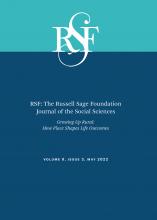Research Article
Open Access
When Mamaw Becomes Mom: Social Capital and Kinship Family Formation amid the Rural Opioid Crisis
Kristina Brant
RSF: The Russell Sage Foundation Journal of the Social Sciences May 2022, 8 (3) 78-98; DOI: https://doi.org/10.7758/RSF.2022.8.3.03
Kristina Brant
aAssistant professor of rural sociology at Pennsylvania State University, United States

REFERENCES
- ↵
- Ahmad, Farida B.,
- Lauren Rossen, and
- Laura Pegram
- ↵
- Anderson, Lydia
- ↵
- Annie E
- ↵
- Atkinson, Rowland, and
- John Flint
- ↵
- Barnett, Melissa A
- ↵
- Beety, Valena E
- ↵
- Berrick, Jill Duerr
- ↵
- Bowen, Sarah,
- Sinikka Elliott, and
- Annie Hardison-Moody
- ↵
- Brown, J. Brian, and
- Christopher T. Lichter
- ↵
- Brown, Stephanie,
- Don Cohon, and
- Rachel Wheeler
- ↵
- Case, Anne, and
- Angus Deaton
- ↵
- Clair, Matthew
- ↵
- Clark, Shelley,
- Sam Harper, and
- Bruce Weber
- ↵
- Contreras, Monica,
- Lisette Caudillo,
- Andres Villarreal, and
- Philip N. Cohen
- ↵
- Cornut St-Pierre, Pascale
- ↵
- Cross, Christina J
- ↵
- Crumbley, Joseph, and
- Robert L. Little
- ↵
- ↵
- Davis, Margot Trotter,
- Marji Erickson Warfield,
- Janet Boguslaw,
- Dakota Roundtree-Swain, and
- Gretchen Kellogg
- ↵
- ↵
- Drescher, Jessica,
- Anne Podolsky,
- Sean F. Reardon, and
- Gabrielle Torrance
- ↵
- Duncan, Cynthia M
- ↵
- Dunfee, Madeline Nicole,
- Robyn Lewis Brown, and
- Nancy E. Schoenberg
- ↵
- Dunifon, Rachel E
- ↵
- Economic Research Service
- ↵
- Eller, Ronald D
- ↵
- Eller, Ronald D
- ↵
- Ewick, Patricia, and
- Susan S. Silbey
- ↵
- Gaventa, John
- ↵
- ↵
- ↵
- Hansen, Anna C.,
- Robyn Brown,
- Peggy Keller, and
- Nancy Schoenberg
- ↵
- Keister, Lisa A.,
- James W. Moody, and
- Tom Wolff
- ↵
- Kentucky Youth Advocates (KYA)
- ↵
- Kentucky Youth Advocates (KYA)
- ↵
- Keyes, Katherine M.,
- Magdalena Cerdá,
- Joanne E. Brady,
- Jennifer R. Havens, and
- Sandro Galea
- ↵
- Lewin, Philip G
- ↵
- Li, Ke
- ↵
- Macy, Beth
- ↵
- Mandelbaum, Randi
- ↵
- McDonald, Douglas C.,
- Kenneth Carlson, and
- David Izrael
- ↵
- Merry, Sally E
- ↵
- Miller, Emily E. N., and
- Kathryn Edin
- ↵
- Moen, Phyllis, and
- Elaine Wethington
- ↵
- Monnat, Shannon, and
- Khary Rigg
- ↵
- Nielsen, Laura B
- ↵
- Patton, Michael Quinn
- ↵
- Pilkauskas, Natasha V., and
- Christina Cross
- ↵
- Pittman, LaShawnDa
- ↵
- Pittman, LaShawnDa
- ↵
- Pruitt, Lisa R
- ↵
- Pruitt, Lisa R
- ↵
- Pruitt, Lisa R., and
- Bradley Showman
- ↵
- Quinones, Sam
- ↵
- Rankin, Sonia G
- ↵
- Rigg, Khary K.,
- Shannon M. Monnat, and
- Melody N. Chavez
- ↵
- ↵
- Roberts, Dorothy
- ↵
- ↵
- Sarat, Austin
- ↵
- Scholl, Lawrence,
- Puja Seth,
- Mbabazi Kariisa,
- Nana Wilson, and
- Grant Baldwin
- ↵
- Small, Mario L
- ↵
- Spalding, Ashley
- ↵
- Stack, Carol
- ↵
- Substance Abuse and Mental Health Services Administration (SAMHSA)
- ↵
- Weiss, Robert S
- ↵
- Wilt, Grete E.,
- Brian E. Lewis, and
- Erica E. Adams
- ↵
- Yancura, Loriena A.,
- Jessie L. Piper,
- Heather S. Wallace, and
- Ann A. Berry
- ↵
- Young, Kathryne M
- ↵
- Young, Kathryne M.. and
- Katie R. Billings
- ↵
- Zinn, Andrew
In this issue
When Mamaw Becomes Mom: Social Capital and Kinship Family Formation amid the Rural Opioid Crisis
Kristina Brant
RSF: The Russell Sage Foundation Journal of the Social Sciences May 2022, 8 (3) 78-98; DOI: 10.7758/RSF.2022.8.3.03
Jump to section
Related Articles
- No related articles found.
Cited By...
- No citing articles found.





